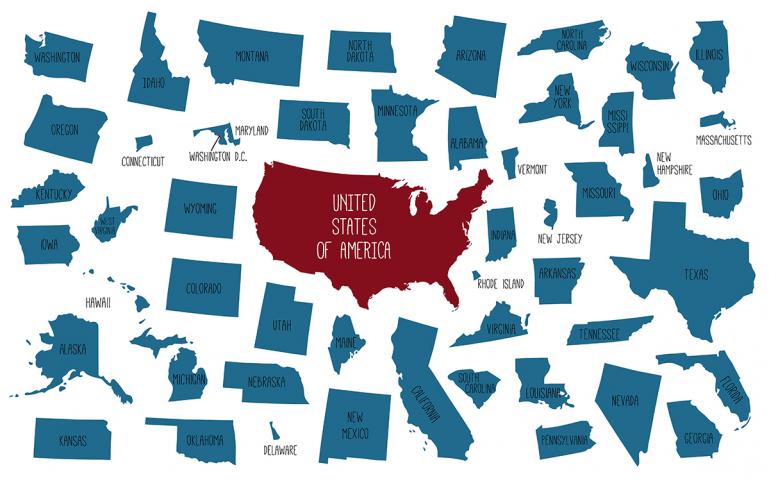
(from sierraclub.org)
Should gun advocates embrace States’ Rights?
In McDonald v Chicago, the Supreme Court incorporated the Second Amendment on the States. “[T]he right of the People to keep and bear arms . . .” is now, indisputably, the uniform law of the land throughout the 50 states and D.C. Yet for the foreseeable future, that “uniform” right means nothing more than what the Supremes decide is “. . . the right . . . really worth insisting upon.” Thus, as a purely practical matter, we cannot know the precise bounds of “the right” until the fullness of time when the whim of the Supremes may be revealed to us.
Strategically, rights and control belligerents must decide whether to field the battle in Washington, D.C. or in the 50 state legislatures. If control advocates can breach the Congressional citadel then the right will be swiftly ground to dust. Many rights advocates recognize this all-eggs-in-one-basket vulnerability and resist the temptation to advocate for Congressional legislation advancing rights. (Some rights advocates even object to federal National Carry Reciprocity on any pretense.)
Control advocates have also recognized the difficulty of overcoming Congressional resistance to gun control. They are turning to state-by-state fights for incremental measures such as “assault weapons” bans and universal background checks. The states’ rights strategy is proving to be a long, slow, expensive grind. Rights advocates should see this as a successful diversion of the battlefield to our high ground position. Control advocates do have a near unlimited war chest they can use to win by attrition. Even so, until the last state falls—perhaps Alaska—the ultimate flicker of light from the Second Amendment will not have been extinguished. Keep your powder dry.
Purist rights advocates want to insist that legislative power to control guns is uniformly negligible. This is a sound, principled position, but may be a flawed strategy. Control advocates will be only too eager to agree that the power to control guns is uniform. If rights advocates concede this point, there remains only the question whether that power is zero, minute, or to what degree. We might imagine that the opposition will agree to minimal power. But it is here where the control advocates will begin the bidding at major and then bargain for total power.
Strategically, rights advocates can be better off defending the 50 outposts of the legislatures in the several states. Our position ought to be as follows: There is one uniform standard for the right ordained by the Second Amendment, and it is limited. First, and most clearly, it specifically empowers “the People”, not the government. The right is to “keep and bear”, although not to use arms in a manner jeopardizing public safety. What weapons might fall outside the definition of “arms” will never be known with complete certainty; for example, what about the garrote?
The power of legislatures to limit the extent of that right must necessarily be divided between the national and state governments. Our federal system has divided the spheres of influence fairly consistently: The federal government is concerned with international and interstate affairs whereas the state governments are left with the “police power” to regulate their domestic affairs. While executed imperfectly, gun control has generally been divided according to this federal principle. Interstate commerce in firearms is governed by federal laws; keeping and bearing arms is regulated, or not, by the laws of the several states.
As one example, there is a right of the People to possess long guns, but at what age? Various states set the minimum age for possession of a long gun at 21, 18, 16, 14, or none. If we admit Congress’s power to specify a minimum age for militia duty must we then concede that it also has the power to specify a nationwide minimum age for possession of long arms? How shall we persuade the peoples of two dozen states to deprive their children of the right to long guns? As of this writing, only Illinois sets the minimum at 21 and only 15 states at 18.
As another example, how could be a uniform standard for prescribing “gun-free” zones? Hawaii might tightly constrain carry in every municipality whereas Alaskans may need to carry everywhere in their state if they are to be armed against dangerous fauna.
Now that Brett Kavanaugh has ascended to the Supreme Court, two contentious issues are apt to be decided soon. These are the extent to which states can regulate carry in public places and the features of “assault weapons”. It is unlikely that the Supremes will rule broadly in either domain. They will not declare Constitutional carry by everyone everywhere. They will not authorize every “evil feature” of every firearm. Rather, they are apt to move cautiously.
One can imagine SCOTUS declaring that no state may forbid carry other than by objective and explicit criteria–for example, that they may regulate carry, open or concealed, by age. States may forbid carry by “prohibited persons” as defined by law and subject to judicial review. They may require permitting with prerequisites such as background checks, training or testing. But they may not forbid carry based on a subjective test of “need”.
One can imagine the Supremes declaring that no state may forbid possession of a weapon based upon cosmetic definitions of “evil features”. Criteria such as barrel shrouds, vertical grips, and threaded barrels would probably be explicitly ruled out. Any prohibited feature must be justified by some objective rationale. How, exactly, does a pistol grip operate to create a public safety risk? Presuming some regulation of over-all length of a long-arm, how does the presence of an adjustable stock (e.g., to accommodate length-of-pull for family members of diverse ages) create a public safety risk?
Magazine capacity is apt to be a difficult issue. Consider the contrasting cases of Manhattan, New York versus Manhattan, Kansas. Arguably, New York City might try to outlaw carrying or transporting magazines with more than 5 rounds outside the home. The Kansas legislature is unlikely to expect its residents to face down a sounder of feral hogs with any limit on magazine size. Possession for home defense or in conformance with a Congressional mandate for arming of the militia would be entirely separate matters.
For the foreseeable future, there is simply no practical way to formulate any national standard for gun control that could gain acceptance simultaneously in blue, purple and red states. The Supremes may move slowly trying to accommodate the delicate sensibilities of the blue states. They may never move so far as to impose a red state view upon urban states. What we can reasonably expect is that the Supreme Court will gradually trim back the most egregious infringements of several states and at the same time keep Congress within its interstate jurisdiction.
As rights advocates, our task may become how to make the best of the never ending push for gun control under a states’ rights interpretation of the “police power”. Divided we stand, and divided we can prevail.
 —‘MarkPA’ is trained in economics, a life-long gun owner, NRA Instructor and Massad Ayoob graduate. He is inspired by our inalienable rights to “life, liberty and the pursuit of happiness” and holds that having the means to defend oneself and one’s community is vital to securing them.
—‘MarkPA’ is trained in economics, a life-long gun owner, NRA Instructor and Massad Ayoob graduate. He is inspired by our inalienable rights to “life, liberty and the pursuit of happiness” and holds that having the means to defend oneself and one’s community is vital to securing them.
